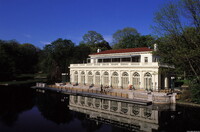| dc.coverage.spatial | Site: New York, New York, United States | en_US |
| dc.coverage.temporal | 1865-1873 (creation) | en_US |
| dc.creator | Olmsted, Frederick Law, Sr. | en_US |
| dc.creator | Vaux, Calvert | en_US |
| dc.date | 1865-1873 | en_US |
| dc.date.accessioned | 2013-07-11T19:26:52Z | |
| dc.date.available | 2013-07-11T19:26:52Z | |
| dc.date.issued | 1865-1873 | en_US |
| dc.identifier | 224057 | en_US |
| dc.identifier.other | archrefid: 545 | en_US |
| dc.identifier.uri | http://hdl.handle.net/1721.3/132684 | |
| dc.description | Boathouse (1905, now Visitor Center), view over the lake; Olmsted returned to New York in 1865 to join Calvert Vaux in designing Prospect Park (1865-1873) in Brooklyn. The Long Meadow at Prospect Park is the best example of Olmsted's use of his Pastoral manner, which was the most important style for him. He had experienced the style in its purest and most powerful form in his tours of the parks of estates in the British Isles. The graceful undulation of the terrain invited movement through it, producing a sense of enlarged freedom. With its seemingly unbounded undulating terrain, pools and groups of trees, Pastoral landscape, Olmsted believed, served as a specific antidote to the congestion, noise and artificiality of the city. Olmsted was convinced that the appeal of Pastoral landscape was not simply a passing fashion: rather, it appealed to the 'common and elementary impulses of all classes of mankind'. In terrain too steep for Pastoral treatment, Olmsted provided a contrasting experience by employing the Picturesque style. He used a great variety of plant materials, creating a layering of textures. The effect he sought was one of richness and profusion, combined with a sense of mystery produced by dark shadows under scintillating, sunlit foliage. He had experienced this landscape most intensely at the edge of the rainforest in Panama. Source: Grove Art Online; http://www.groveart.com/ (accessed 2/8/2008) | en_US |
| dc.rights | © Scott Gilchrist, Archivision, Inc. | en_US |
| dc.subject | architectural exteriors | en_US |
| dc.subject | landscapes | en_US |
| dc.subject | recreation and games | en_US |
| dc.subject | festivals | en_US |
| dc.subject | parks (recreation areas) | en_US |
| dc.subject | Nineteenth century | en_US |
| dc.subject | Picturesque, the | en_US |
| dc.title | Prospect Park | en_US |
| dc.type | image | en_US |
| dc.rights.access | Licensed for educational and research use by the MIT community only | en_US |
| dc.identifier.vendorcode | 2A1-OF-PP-2-D3 | en_US |
| vra.culturalContext | American | en_US |
| vra.technique | gardening | en_US |
| vra.worktype | park (recreation area) | en_US |
| dc.contributor.display | Calvert Vaux (American architect, 1824-1895); Frederick Law Olmsted Sr. (American landscape architect, 1822-1903) | en_US |


